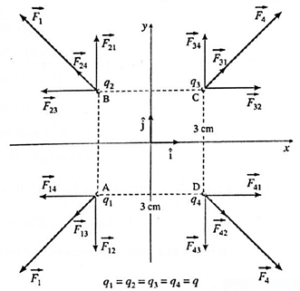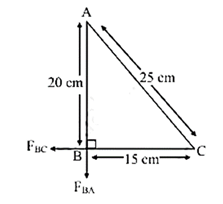Electrostatics
Maharashtra Board-Class-11-Science-Physics-Chapter-10
Solutions
Question 1. Choose the correct option.
(i) A positively charged glass rod is brought close to a metallic rod isolated from ground. The charge on the side of the metallic rod away from the glass rod will be
(A) same as that on the glass rod and equal in quantity
(B) opposite to that on the glass of and equal in quantity
(C) same as that on the glass rod but lesser in quantity
(D) same as that on the glass rod but more in quantity
(C) same as that on the glass rod but lesser in quantity
(ii) An electron is placed between two parallel plates connected to a battery. If the battery is switched on, the electron will
(A) be attracted to the +ve plate
(B) be attracted to the -ve plate
(C) remain stationary
(D) will move parallel to the plates
(A) be attracted to the +ve plate
(iii) A charge of +7 μC is placed at the centre of two concentric spheres with radius 2.0 cm and 4.0 cm respectively. The ratio of the flux through them will be
(A) 1:4
(B) 1:2
(C) 1:1
(D) 1:16
(C) 1:1
(iv) Two charges of 1.0 C each are placed one meter apart in free space. The force between them will be
(A) 1.0 N
(B) 9 × 109 N
(C) 9 × 10−9 N
(D) 10 N
(B) 9 × 109 N
(v) Two point charges of +5 μC are so placed that they experience a force of 80×10-3 N. They are then moved apart, so that the force is now 2.0×10-3 N. The distance between them is now
(A) 1/4 the previous distance
(B) double the previous distance
(C) four times the previous distance
(D) half the previous distance
(B) double the previous distance
(vi) A metallic sphere A isolated from ground is charged to +50 μC. This sphere is brought in contact with other isolated metallic sphere B of half the radius of sphere A. The charge on the two sphere will be now in the ratio
(A) 1:2
(B) 2:1
(C) 4:1
(D) 1:1
(B) 2:1
(vii) Which of the following produces uniform electric field?
(A) point charge
(B) linear charge
(C) two parallel plates
(D) charge distributed an circular any
(C) two parallel plates
(viii) Two point charges of A = +5.0 μC and B = -5.0 μC are separated by 5.0 cm. A point charge C = 1.0 μC is placed at 3.0 cm away from the centre on the perpendicular bisector of the line joining the two point charges. The charge at C will experience a force directed towards
(A) point A
(B) point B
(C) a direction parallel to line AB
(D) a direction along the perpendicular bisector.
(C) a direction parallel to line AB
Question 2. Answer the following questions.
(i) What is the magnitude of charge on an electron?
The magnitude of charge on an electron = 1.602 × 10−19C.
(ii) State the law of conservation of charge.
In any closed or isolated system, the algebraic sum of all the electric charges is constant, i.e., the net charge cannot be created or destroyed.
(iii) Define a unit charge.
- The SI unit of charge is the coulomb (C).
- Using Coulomb's law, it is defined as follows : One coulomb is the amount of charge, which placed at a distance of one metre from another charge of the same magnitude in vacuum, experiences a force of 9.0 x 109
(iv) Two parallel plates have a potential difference of 10 V between them. If the plates are 0.5 mm apart, what will be the strength of electric charge.
Given : V = 10 V, d = 0.5 mm = 5 x 10−4 m
The strength of the electric field,
E = \(\frac{V}{d}\) = \(\frac{10}{5×10^{-4}}\) = 2 x 104 V/m = 2 x 104 N/C
(v) What is uniform electric field?
A uniform electric field is an electric field that has the same magnitude and the same direction at all points in a given region.
(vi) If two lines of force intersect of one point. What does it mean?
If two lines of force intersect at a point, it would mean electric field has two directions at that point. This is impossible.
(vii) State the units of linear charge density.
SI unit of linear charge density λ is (C/m).
(viii) What is the unit of dipole moment?
The SI unit of electric dipole moment is the coulomb-metre (C.m). The debye (D) is a non SI unit of electric dipole moment.
1 debye = 3.33564 x 10—30 coulomb-metre.
(ix) What is relative permittivity?
The relative permittivity (εr) ( ≡ dielectric constant) of a medium is the ratio of the absolute permittivity of the medium (ε) to the absolute permittivity of free space (≡ vacuum (ε0)).
Relative permittivity εr = \(\frac{ε}{ε_0}\)
Question 3. Solve numerical examples.
(i) Two small spheres 18 cm apart have equal negative charges and repel each other with the force of 6 × 10−3 N. Find the total charge on both spheres.
Given : r = 18 cm = 18 x 10−2m, F = 6 x 10−8 , \(\frac{1}{4πε_0}\) = 9 x 109 Nm2/C2,
q1 = q2 = q(Say)
F = \(\frac{1}{4πε_0}(\frac{q_1q_2}{r^2})\) = \(\frac{1}{4πε_0}(\frac{q^2}{r^2})\)
∴ q2 = F (4πε0) r2 = \(\frac{(6×10^{-8})(18×10^{-2})}{9×10^9}\)
= 6 x 2 x 18 x 10−21 = 21.6 x 10−20
∴ q = \(\sqrt{21.6}\) x 10−10 = −4.648 x 10−10 ….(as the charge is negative)
∴ 2q = −9.296 x 10−10 C
This gives the total charge on both spheres.
(ii) A charge +q exerts a force of magnitude -0.2 N on another charge -2q. If they are separated by 25.0 cm, determine the value of q.
Given : F = — 0.2 N, r = 25.0 cm = 0.25 m, q1 = +q, q2 = −2q, \(\frac{1}{4πε_0}\) = 9 x 109 N.m2/C2,
F = \(\frac{1}{4πε_0}(\frac{q_1q_2}{r^2})\) = \(\frac{1}{4πε_0}(\frac{-2q^2}{r^2})\)
∴ -2q2 = F (4πε0) r2 = \(\frac{(-0.2)×(0.25)^2}{9×10^9}\)
∴ q2 = \(\frac{(0.1)×(0.625)}{9×10^9}=\frac{62.5}{9}\) x 10−12
∴ q = \(\frac{\sqrt{62.5}}{3}\) x 10−6
= 2.635 x 10−6 C = 2.635 μC
(iii) Four charges of +6 × 10−8 C each are placed at the corners of a square whose sides a are 3 cm each. Calculate the resultant force on each charge and show its direction on a diagram drawn to scale.
Given : q1 = q2 = q3 = q4 = q = +6 × 10−8 C, a = 3 cm = 3 x 10−2 m, \(\frac{1}{4πε_0}\) = 9 x 109 N.m2/C2

Each charge is repelled by the other three. The charges being equal, the magnitudes, F14, F12 , F21 , F23, F32, F34, F41 and F43 are all equal to
\(\frac{1}{4πε_0}(\frac{q^2}{a^2})\) = \(\frac{(9×10^9)(6×10^{-8})^2}{(3×10^{-2})^2}\) = 36 mN
With \(\vec{F}_{14}=-\vec{F}_{41}\), \(\vec{F}_{12}=-\vec{F}_{21}\), \(\vec{F}_{23}=-\vec{F}_{32}\), and \(\vec{F}_{34}=-\vec{F}_{43}\),
Also, F13, F31, F24 and F42 are equal to
\(\frac{1}{4πε_0}(\frac{q^2}{2a^2})\) = \(\frac{(9×10^9)(6×10^{-8})^2}{2(3×10^{-2})^2}\) = 18 mN
With the choice of axes as shown in Fig. the unit vectors along \(\vec{CA}\), \(\vec{AC}\), \(\vec{DB}\), and \(\vec{BD}\)
are respectively, \(\frac{-\hat{i}-\hat{j}}{\sqrt{2}}\), \(\frac{\hat{i}+\hat{j}}{\sqrt{2}}\), \(\frac{-\hat{i}+\hat{j}}{\sqrt{2}}\) and \(\frac{\hat{i}-\hat{j}}{\sqrt{2}}\)
The net force on q1 is
\(\vec{F}_1=\vec{F}_{12}+\vec{F}_{14}+\vec{F}_{13}\)
= (36)(\(-\hat{j}\)) + (36)(\(-\hat{i}\) ) + (18)\((\frac{-\hat{i}-\hat{j}}{\sqrt{2}})\)
= (36 + 9\((\sqrt{2}\))\((-\hat{i}-\hat{j})\) = (48.73 mN)\((-\hat{i}-\hat{j})\)
∴ The net force on q3 is
\(\vec{F}_3=-\vec{F}_1\) = (48.73 mN)\((\hat{i}+\hat{j})\)
The net force on q2 is
\(\vec{F}_2\) = (48.73 mN)\((-\hat{i}+\hat{j})\)
and the net force on q4 is
\(\vec{F}_4=-\vec{F}_2\) = (48.73 mN)\((\hat{i}-\hat{j})\)
F1 = F2 = F3 = F4 = 48.73\(\sqrt{2}\) mN = 68.92 mN
(iv) The electric field in a region is given by \(\vec{E}\) = 5.0\(\hat{k}\) N/C. Calculate the electric flux Through a square of side 10.0 cm in the following cases.
(a) the square is along the XY plane
(b) The square is along XZ plane
(c) The normal to the square makes an angle of 450 with the Z axis.
Given : \(\vec{E}\) = 5.0\(\hat{k}\) V/m, a = 10.0 cm = 0.1 m
Flux, ø = \(\vec{E}.\vec{dS}\)
(i) The square is along the xy-plane. The corresponding area vector,
\(\vec{dS}\) = a2\(\hat{k}\) = 0.01 \(\hat{k}\) m2
∴ The electric flux through the square
= \(\vec{E}\)·(0.01 \(\hat{k}\)) = (5 \(\hat{k}\) V/m)·(10-2 \(\hat{k}\) m2)
= 5 x 10-2 V.m ….(as \(\hat{k}\).\(\hat{k}\) = 1)
(ii) The square is along the xz-plane.
The corresponding area vector,
\(\vec{dS}\) = a2 \(\hat{j}\) = (10-2 m2)\(\hat{j}\)
∴ The electric flux = (5 \(\hat{k}\) V/m)·(10-2 \(\hat{j}\) m2) = 0 …. (as \(\hat{k}\).\(\hat{j}\) = 0)
Alternatively, the square is parallel to so that electric field lines do not pass through the square. Hence, the electric flux through the square is zero.
(iii) The normal to the square makes an angle θ = 45° with the z-axis.
cos θ = cos 450 = \(\frac{1}{\sqrt{2}}\)
.'. The electric flux through the square
= E S cos θ
= (5 V/m) (10-2 m2) x \(\frac{1}{\sqrt{2}}\)
= 5 × 10-2 × 0.7071
= 3.5355 × 10-2 V/m
(v) Three equal charges of 10 × 10−8 C respectively, each located at the corners of a right triangle whose sides are 15 cm, 20 cm and 25 cm respectively. Find the force exerted on the charge located at the 90° angle.
Given: qA = qB = qC = 10 x 10−8 C

Force on B due to A,
\(\vec{F}_{BA}\) = \(\frac{1}{4πε_0}(\frac{q_A.q_B}{r^2_{AB}})\) = \(\frac{(9×10^9)(10×10^{-8})^2}{(20×10^{-2})^2}\)
= 2.25 x 10-3 N
Force on B due to C,
\(\vec{F}_{BC}\) = \(\frac{1}{4πε_0}(\frac{q_C.q_B}{r^2_{CB}})\) = \(\frac{(9×10^9)(10×10^{-8})^2}{(15×10^{-2})^2}\)
= 4 x 10-3 N
∴ Resultant force on point B,
|FB| = \(\sqrt{F_{BA}^2+F_{Bc}^2+2F_{BA}.F_{BC}\,cos\,90^0}\)
= \(\sqrt{(2.25×10^{-3})^2+(4×10^{-3} )^2}\)
= 4.589 x 10−3 N
Force exerted on charge at point B is 4.589 x 10−3 N
(vi) A potential difference of 5000 volt is applied between two parallel plates 5 cm a part a small oil drop having a charge of 9.6 ×10−19 C falls between the plates. Find (a) electric field intensity between the plates and (b) the force on the oil drop.
Given: V = 5000 volt, d = 5 cm = 5 x 10−2 m, q = 9.6 x 10−9 c, a. Electric field intensity (E) = ? Force (F) = ?
(a) Electric field intensity between the plates E = \(\frac{V}{d}=\frac{5000}{5×10^{-2}}\) = 1 x 105 N/C
(b) The force on the oil drop F = qE = (9.6 x 10−9) x (1 x 105) = 9.6 x 10−14 N
(vii) Calculate the electric field due to a charge of −8.0 × 10−8 C at a distance of 5.0 cm from it.
Given : q = —8 x 10−8 C, r = 5.0 cm = 5 x 10−2 m, \(\frac{1}{4πε_0}\) = 9 x 109 N.m2/C2,
The magnitude of electric field
E = \(\frac{1}{4πε_0}.\frac{q^2}{r^2}\) = \((9×10^9).\frac{(-8×10^{-8})^2}{(5×10^{-2})^2}\) = \(-\frac{72}{25}\) x 105 = −2.88 x 105
Main Page : – Maharashtra Board Class 11th-Physics – All chapters notes, solutions, videos, test, pdf.
Previous Chapter : Chapter 9: Optics – Online Solutions
Next Chapter : Chapter 11: Electric Current Through Conductors – Online Solutions
We reply to valid query.